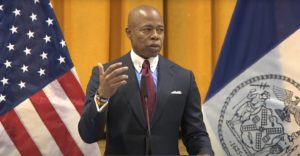Funding failure: New York City is giving more money to schools with declining enrollment
As taxpayer spending on public education rises nationwide, New York City is singling out schools with fewer students for additional aid.
NYC Mayor Eric Adams announced Tuesday he will be giving…

As taxpayer spending on public education rises nationwide, New York City is singling out schools with fewer students for additional aid.
NYC Mayor Eric Adams announced Tuesday he will be giving $75 million of additional funds specifically to schools with shrinking student populations.
Roughly 250 (15%) of New York City Public Schools (NYCPS) will benefit from the move, which is part of the city’s broader effort to fill the gaps of the soon-to-be expired pandemic-era funding.
Last month, NYCPS Chancellor David Banks explained at a city council meeting that the city would be spending $500 million to make up for expiring federal funds.
The money will pay for “500 social workers and psychologists, community schools, arts programming, programming for at-risk adults and older youth, [Public Schools Athletic League], students in temporary housing coordinators, translation and interpretation services and bilingual education,” said Banks.
Nevertheless, the council still worried about finding funding for nursing staff, special education, and cafeteria menus.
While some might wonder why the city used temporary funding sources to pay for recurring expenses, the bigger question is why it’s giving the same budget to schools with fewer students – especially when the average per-pupil funding in NYC is already $38,000 a year.
In a report on NYC education spending, the Citizens Budget Commission estimated 100,000 fewer students will attend NYC public schools in 2025 than prior to the pandemic.
Nevertheless, local funding is expected to increase by $2.1 billion (or 10.2%) and state funding by $200 million – presumably to replace the $2.4 billion of the temporary federal funding.
“This is a huge win,” Mayor Adams said at a news conference. “We’re going to have to deal with this issue long-term, but right now we want to stabilize our schools.”
“The most important thing is that schools know, as they are now planning to open up schools in September, they can walk with a certain level of [assurance] that they will be able to have a full budget,” added Chancellor Banks.
And NYC isn’t the only place where declining enrollment is being met with growing budgets.
In Ohio, between 2002 and 2020, inflation-adjusted per-pupil funding increased by over $2,000 even while the student population dropped nearly 8%.
During the same time period, the number of teachers declined 13% while non-teaching staff increased by 117%.
Other states where funding has climbed amid drops in student enrollment include New Hampshire, Illinois and Massachusetts.



